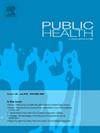Higher cumulative blood pressure is associated with increased risk of incident stroke but not heart disease among middle-aged and older Chinese adults: A prospective cohort study
IF 3.9
3区 医学
Q1 PUBLIC, ENVIRONMENTAL & OCCUPATIONAL HEALTH
引用次数: 0
Abstract
Objectives
To examine the associations of cumulative systolic blood pressure (SBP)/diastolic blood pressure (DBP)/pulse pressure (PP) with the incident heart disease and stroke, as well as the dose-response relationship between them.
Study design
Longitudinal prospective cohort study.
Methods
The present cohort was drawn from the China Health and Retirement Longitudinal Study during 2011–2018. The Kaplan-Meier method was used to calculate the cumulative incidence of heart disease and stroke by quartiles of cumulative BP among participants, and the hazard ratios (HRs) and 95% confidence intervals (CIs) for heart diseases and stroke risk associated with the cumulative BP were estimated using Cox proportional hazards models. Restricted cubic spline plots were used to elucidate the dose–response relationship.
Results
After adjusting for multiple covariates, higher levels of cumulative SBP/DBP were found to be associated with the increased risk of incident stroke (HR for cumulative SBP: 2.11, 95% CI: 1.31–3.41; HR for cumulative DBP: 1.97, 95% CI: 1.25–3.11), but not heart diseases (HR for cumulative SBP: 1.21, 95% CI: 0.83–1.78; HR for cumulative DBP: 1.17, 95% CI:0.81–1.68). In stratified analyses, we found that age modified the positive association between high cumulative DBP and incident stroke, which more evident in subjects younger than 65 years. Besides, cumulative BP had no nonlinear dose-response relationship with the risk of heart diseases or stroke (P > 0.05).
Conclusions
These findings suggested that higher levels of cumulative SBP/DBP increased the risk of incident stroke, while no significant association was observed for incident heart disease and cumulative BP level.
在中国中老年人中,较高的累积血压与卒中风险增加有关,但与心脏病风险无关:一项前瞻性队列研究
目的探讨累积收缩压(SBP)/舒张压(DBP)/脉压(PP)与心脏病和脑卒中发病的关系及其量效关系。研究设计:纵向前瞻性队列研究。方法本队列来自2011-2018年中国健康与退休纵向研究。采用Kaplan-Meier方法按受试者累积血压的四分位数计算心脏病和卒中的累积发病率,并使用Cox比例风险模型估计与累积血压相关的心脏病和卒中风险的风险比(hr)和95%置信区间(CIs)。用限制三次样条图说明剂量-反应关系。结果在调整多个协变量后,发现较高的累积收缩压/舒张压水平与卒中发生风险增加相关(累积收缩压HR: 2.11, 95% CI: 1.31-3.41;累积舒张压的HR: 1.97, 95% CI: 1.25-3.11),但没有心脏病(累积收缩压的HR: 1.21, 95% CI: 0.83-1.78;累积DBP的HR: 1.17, 95% CI: 0.81-1.68)。在分层分析中,我们发现年龄改变了高累积DBP与卒中事件之间的正相关关系,这在65岁以下的受试者中更为明显。此外,累积血压与心脏病或脑卒中风险无非线性剂量反应关系(P >;0.05)。结论:较高的累积收缩压/舒张压水平增加了卒中发生的风险,而心脏病的发生与累积血压水平无显著关联。
本文章由计算机程序翻译,如有差异,请以英文原文为准。
求助全文
约1分钟内获得全文
求助全文
来源期刊

Public Health
医学-公共卫生、环境卫生与职业卫生
CiteScore
7.60
自引率
0.00%
发文量
280
审稿时长
37 days
期刊介绍:
Public Health is an international, multidisciplinary peer-reviewed journal. It publishes original papers, reviews and short reports on all aspects of the science, philosophy, and practice of public health.
 求助内容:
求助内容: 应助结果提醒方式:
应助结果提醒方式:


